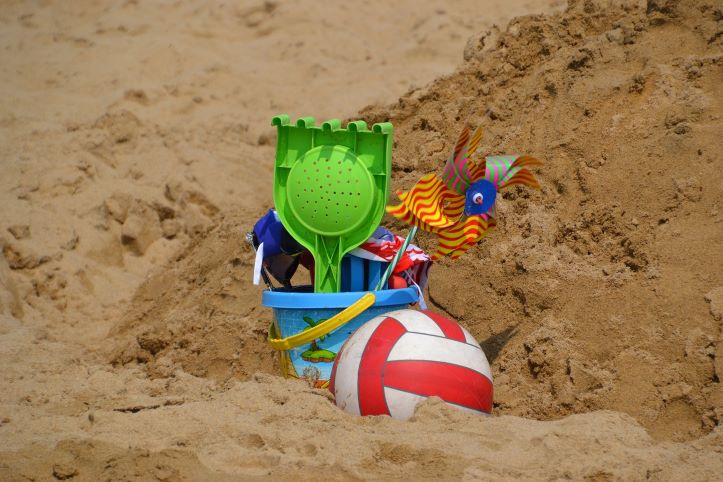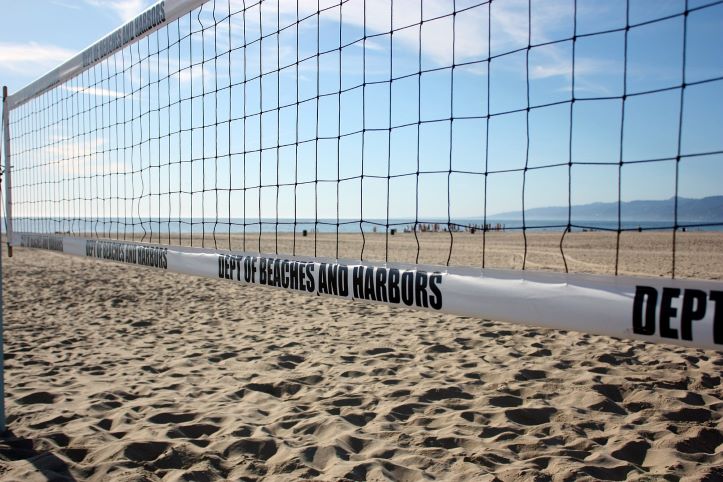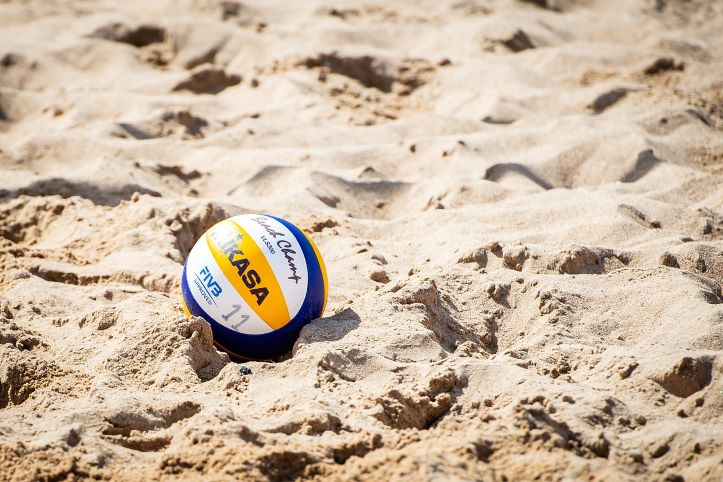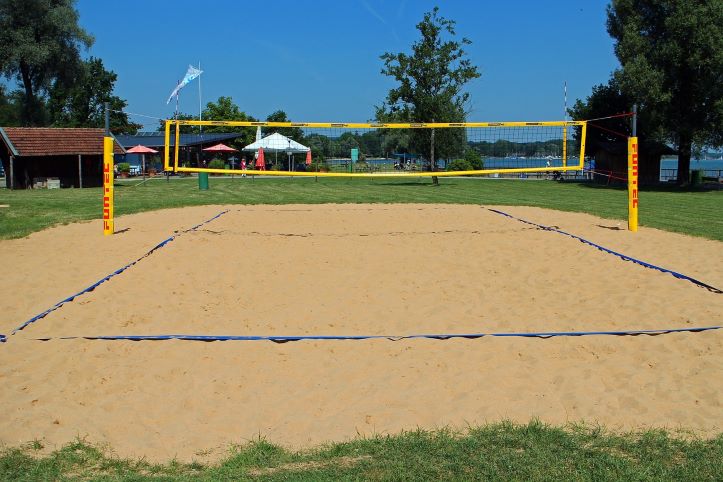Sand volleyball courts have gained immense popularity over the years, and for good reason. These outdoor places combine recreation, fitness, and socialization perfectly. People looking for active, fascinating hobbies love them.
Sand volleyball courts aren’t just for professional sports. They’ve overtaken parks, beaches, and backyards. Sand volleyball benefits from its accessibility to all skill levels. A sand volleyball court is perfect for beginners and pros alike.
Imagine a sand volleyball court in your home or local park. Many benefits. Organize impromptu games, weekend tournaments, and memorable moments with friends and family. It’s perfect for exercise and outdoor fun. Additionally, it makes your property a social hub for gatherings and enjoyable activities. So, today you are going to learn how to build a sand volleyball court in the easiest way possible. Just follow the guides.
6 Easy Steps to build your own sand volleyball court
# Planning Your Sand Volleyball Court
Choose the Right Location for Your Court
Selecting the perfect location for your sand volleyball court is the first crucial step in your project. Look for a spot that receives ample sunlight throughout the day to keep the sand dry and comfortable for players. While most people envision beachfront settings, your backyard or a spacious corner of a park can work just as well. Ensure that the chosen spot is relatively flat and free of obstructions like large rocks, tree roots, or utility lines. These factors will make the construction process smoother and the court safer for play.
Determine the Ideal Court Size
The size of your sand volleyball court plays a significant role in the game’s enjoyment. A regulation-size court is 26.3 feet by 52.6 feet (8 meters by 16 meters). However, if you have limited space or prefer a smaller court, you can adjust the dimensions accordingly. For example, a popular smaller size is 25 feet by 50 feet (7.6 meters by 15.2 meters), which is still suitable for competitive play. On the other hand, if you’re just looking for a casual setup, a 20 feet by 40 feet (6.1 meters by 12.2 meters) court can be ideal. The key is to find a size that fits your available space and your intended level of play.

Gather the Necessary Tools and Materials
To bring your sand volleyball court to life, you’ll need several tools and materials.
Common items include:
- wooden boundary stakes
- measuring tape
- a level
- a shovel
- a rake for site preparation
For the court itself, you’ll need high-quality sand. Volleyball-specific sand is the best choice due to its optimal texture and consistency. Depending on your location, you might also need a net, net posts, and boundary lines. Consider using materials that can withstand outdoor conditions for long-lasting durability.
# Preparing the Ground
Marke the Court Boundaries
The success of your sand volleyball court begins with precision. After choosing the perfect location, it’s time to mark your court boundaries. Grab your measuring tape and wooden boundary stakes, and ensure you measure accurately. For a regulation-size court, mark a rectangle that’s 26.3 feet by 52.6 feet (8 meters by 16 meters). If you’ve opted for a smaller court, adjust accordingly. Use bright-colored boundary lines or ropes to make the court’s limits clear. This not only enhances the look but also helps prevent disputes during play.
Before pouring the sand, take a stroll around the court area. Look for any stray rocks, tree roots, or debris that could disrupt your game or pose safety hazards. Remove these obstacles to ensure a level and safe playing environment. It might take a bit of effort. But it’s a small price to pay for the joy you’ll get from your court.
Level the Ground for a Smooth Surface
Now, it’s time to level the ground. Use your level and shovel to fill in any low spots and tamp down any high spots. Aim for a perfectly flat surface, as this will prevent puddles and uneven footing during games. A well-leveled court ensures that the sand distributes evenly and provides a consistent playing experience.
Make a Proper Drainage System
For a proper drainage system for your sand volleyball court, it’s essential to establish it at the lowest point of the court area. Here’s how to do it:
- Assess the natural slope and adjust it if necessary.
- Dig a trench along the lower end of the court.
- Choose a perforated PVC drainage pipe and place it in the trench with the perforations facing down.
- Ensure the drainage pipe follows the slope of the court and directs water away from the playing surface.
- Connect the drainage pipe to a suitable outlet, such as a drainage ditch or storm sewer.
- Backfill the trench with clean gravel and compact it lightly.
- Cover the trench with landscape fabric to prevent clogging.
- Regularly inspect and maintain the drainage system to ensure it functions effectively.
# Building a Sturdy Frame
Construct the Boundary Frames
It’s time to create the essential boundary frames. This not only defines the court but also gives it a professional appearance. There are several options for boundary frames. But a few stand out for their durability and ease of installation:
- Wooden Frames: Treated wooden planks or boards are a popular choice due to their affordability and ease of customization. You can use 2×4 or 4×4 lumber to create sturdy frames. Just ensure they’re properly anchored into the ground to prevent movement during play.
- PVC Pipe Frames: PVC pipes are lightweight, weather-resistant, and easy to work with. They offer a cost-effective solution for building your court’s boundaries. Cut the pipes to the desired lengths and secure them with connectors.
- Metal Frames: Steel or aluminum frames are the most durable option, perfect for permanent sand volleyball courts. They offer excellent stability and longevity, but they might require more effort during installation.
Choose the frame material that suits your budget, skills, and how long you plan to keep your sand volleyball court in place. Regardless of your choice, remember to keep the frames flush with the ground. And ensure they form a perfect rectangle, maintaining the court’s dimensions.
Secure the Posts for the Net
The net is a vital component of your sand volleyball court. Its stability depends on properly secured net posts. You can use various post options:
- In-Ground Posts: These are permanently installed by digging holes and cementing the posts in place. They offer the best stability but require more effort.
- Sleeve Anchors: This method involves placing sleeves in the ground that can receive the net posts. It’s a semi-permanent solution that allows for easier removal and adjustment.
- Portable Net Systems: If you prefer versatility, consider portable net systems that can be easily set up and taken down. They’re great for those who may want to relocate their court in the future.
Precision is the name of the game. Proper measurements ensure that your court adheres to standard dimensions. It prevents disputes during play. A regulation-size sand volleyball court is 26.3 feet by 52.6 feet (8 meters by 16 meters). Any deviations can affect the quality of the game. So, measure twice, cut once. Make sure everything aligns perfectly to guarantee an enjoyable sand volleyball experience.
# Adding the Sand
Select the Right Type of Sand
The type of sand you use can make a significant difference in the quality of your game. Here are some kinds of sand you need for a volleyball court. Also, there are recommendations for the best locations:
- Beach Sand: The golden standard for sand volleyball courts, beach sand is fine, soft, and well-draining. It’s the ideal choice if you want that authentic beach volleyball experience. Best for: Backyard courts and beachfront locations.
- Volleyball Sand: Specifically designed for volleyball. This sand is carefully screened and graded for optimal texture. It’s slightly coarser than beach sand, providing good footing and minimizing dust. Best for: Dedicated sand volleyball courts.
- River Sand: River sand is coarser and less consistent than beach or volleyball sand. It may require more maintenance and grooming to keep the surface even. Best for: Budget-friendly options in areas with limited access to specialty sand.
- Play Sand: Play sand is fine and clean. It is suitable for recreational courts in backyards or parks. However, it may require frequent leveling and raking to maintain an even surface. Best for: Casual, low-traffic courts.
- Crushed Granite Sand: Crushed granite sand is an excellent alternative if you want a firmer surface with good drainage. It’s often used in professional volleyball facilities. But it may require more effort to level. Best for: High-traffic, competitive courts.
Calculate the Required Amount of Sand
The amount of sand you’ll need for your sand volleyball court depends on the court’s size. Here’s a breakdown for different court dimensions:
- Regulation-Size Court (26.3 feet by 52.6 feet): To achieve a 6-inch depth, you’ll need approximately 38 tons (76,000 pounds) of sand.
- Smaller Court (25 feet by 50 feet): For the same 6-inch depth, you’ll require around 34 tons (68,000 pounds) of sand.
- Compact Court (20 feet by 40 feet): A smaller court like this would need approximately 27 tons (54,000 pounds) of sand to reach a 6-inch depth.
These estimates are based on the assumption that one ton of sand covers approximately 100 square feet to a depth of 2 inches. Adjust the amounts according to your court’s specific measurements.
Once you have the right type and amount of sand, it’s time to distribute and level it evenly across your court. Start by dumping the sand in piles throughout the court area. Then, use a rake or leveling board to spread the sand evenly and maintain the desired depth. Keep an eye on the court’s boundaries. Make sure that the sand stays within them. Regular grooming and leveling will help maintain a consistent playing surface over time.
# Setting Up The Net
Install the Net and Tension it Correctly
A crucial aspect of your sand volleyball court is the net. Getting it right ensures a fair and enjoyable game. Here is how to you set up a volleyball net in sand:
- Attach the Net to the Net Posts: Begin by securing the volleyball net to the net posts. Most nets come with attachments or loops that you can use to fasten the net to the posts. Ensure that the net is evenly distributed on both sides of the court.
- Position the Net Posts: Place the net posts at either end of the court, ensuring they are equidistant from the center of the court. The posts should be firmly anchored into the ground or their respective sleeves if you’re using a sleeve anchor system.
- Check Net Tension: Before fully securing the net, check its tension. It should be taut and level horizontally, without any excessive sagging. Adjust the net’s height if necessary based on the level of play you want to achieve.
- Secure the Net: Once you’re satisfied with the net’s tension and height, secure it to the net posts firmly. You can use tensioning devices or straps to keep the net in place and prevent sagging.
- Double-Check the Height: After securing the net, double-check the height to ensure it remains at the desired level. If it sags, re-adjust the tensioning devices as needed.
- Ensure Proper Boundary Alignment: Check that the net aligns with the court’s boundaries on both sides. It should run straight across the center of the court without any kinks or deviations.
- Test the Net for Stability: Give the net a gentle tug to ensure it’s securely attached to the posts and won’t come loose during gameplay.
Types of Nets: There are several types of nets available, including:
- Standard Volleyball Net: These nets are designed for professional play and come in various materials like nylon and polyethylene. They are your go-to for an authentic experience.
- Recreational Volleyball Net: These nets are more affordable and suitable for casual play. They are usually made of lower-cost materials.
- Adjustable Volleyball Net: These nets come with a system to easily adjust the height, making them versatile for players of different skill levels.

To achieve the correct net height, follow these tips.
Tips for Adjusting the Net Height
Sand volleyball does not require higher jumps like indoor volleyball. Regulation net height for men is 7 feet 11 5/8 inches (2.43 meters) and 7 feet 4 1/8 inches (2.24 meters) for women. However, you may want to adjust the net height based on the skill level and preferences of the players. Here’s how to do it:
- For recreational or casual play, set the net at a lower height to make the game more accessible. Around 7 feet (2.13 meters) is a good choice.
- For intermediate players, a net height of around 7 feet 4 inches (2.24 meters) works well.
- Competitive players should aim for the regulation height.
Use the net’s built-in adjustments or mark your net posts for easy height changes. Make sure to measure accurately to maintain fairness in your games.
Secure the Net to Prevent Sagging
Sagging nets can disrupt the flow of the game and lead to disputes. To prevent this, use tensioning devices or tension straps to keep the net taut. These can be attached to the top cable of the net and tightened as needed. Periodically check and adjust the net’s tension to ensure it remains at the desired height and doesn’t sag during play.
# Maintaining Your Court
Sand volleyball court maintenance is the last thing that you should know. Just do the things accordingly and you will have an amazing sand volleyball court of your own.
Regular Raking and Grooming
Sand volleyball courts need regular raking and maintenance. Buy a robust landscaping rake or court grooming tool. Try it after each play session to level the sand, eliminate footprints, and smooth the surface. Keep your court clean with this simple practice.
Address Drainage and Erosion Issues
Watch for drainage and erosion issues. Water pooling on your court? Add a modest slope to one end. Check the court after heavy rains and add sand to prevent erosion. Proper drainage keeps sand in good condition.
Clean Up Debris
Don’t litter your sand volleyball court. Remove leaves, sticks, and other debris from the court to improve play. Regular sweeping and cleaning will keep the court looking good and working. It’s not just about cleaning the volleyball while playing in the sand court. It also about proper cleaning & maintaining the whole court.
Regularly Check Net Tension
Weather and games affect net tension. Regularly inspect and adjust net tension to prevent sagging. Net tension ensures fair and fun games.
Store Equipment Properly
Store boundary lines, posts, and nets while not in use. Weathering can cause damage. Purchase covers or storage options to prolong equipment life.
Inspect the Sand Quality
Sand quality should be checked regularly. It may condense or lose texture with time. Maintain uniformity by adding or aerating sand. High-quality sand enables consistent play.
Organize Regular Maintenance Days
Schedule regular maintenance days with friends or players. This may make maintenance fun and efficient. Grooming sand, checking net tension, and repairing can be done together.

You can just built one sand volleyball easily in your backyard to encourage your lazy child to play. Also, you can motivate the youth in your neighborhood to take interest in sports. As it is a multiple person game.
Sand Volleyball Court Cost Estimate
Building a sand volleyball court is an exciting project. It’s essential to understand the costs involved. Let’s break down the expenses you can expect.
Site Preparation
- This includes clearing and leveling the area. Costs vary based on the complexity of the site.
- Example: $500 – $1,500 for a small backyard court with minimal site work.
Materials and Sand
- The type of sand you choose can affect costs. Beach sand or volleyball-specific sand may be more expensive.
- Example: $1,000 – $3,000 for sand for a standard 26.3′ x 52.6′ court.
Boundary Frames and Net Posts
- The cost of these materials can vary based on the materials you choose (e.g., wood, PVC, or metal).
- Example: $500 – $1,500 for wood or PVC frames and posts.
Net and Accessories
- The cost of the net itself depends on its quality and whether you opt for professional-grade equipment.
- Example: $100 – $300 for a standard net and accessories.
Equipment and Tools
- This includes items like rakes, shovels, and measuring tools.
- Example: $100 – $300 for basic equipment.
Drainage System
- If your location requires a drainage system, this can add to the costs.
- Example: $500 – $1,000 for a simple drainage system.
Labor
- If you hire professionals for site preparation, frame construction, and other tasks, labor costs will apply.
- Example: $1,000 – $3,000 for labor, depending on the complexity of the project.
Optional Features
- These can include lighting, seating, and boundary markings.
- Example: $500 – $2,000 or more for optional features.
Permits and Permissions
- Depending on your location, you may need permits, which can incur fees.
- Example: Permit costs can vary widely, ranging from $50 to several hundred dollars or more.
Maintenance Costs
- Consider ongoing costs for sand replacement, grooming tools, and net maintenance.
- Example: $100 – $500 annually for maintenance.
Total Estimated Cost
- The total cost of your sand volleyball court will depend on your choices and the size of the court, but a ballpark figure for a standard court might range from $4,000 to $10,000 or more.
Conclusion
This guide covers the essentials for building a sand volleyball court. We’ve provided a whole project roadmap, from location to net tension.
Building a sand volleyball court is about creating memories, holding fun events, and encouraging an active, outdoor lifestyle. Waiting for what? Start your own project and soon you’ll be serving fun and spiking down your own sand volleyball court for limitless pleasure. Your friends and family will smile in the sun and sand.
Now, as the court is ready, learn how to become a professional volleyball player.
FAQs
How much sand is needed to make a volleyball court?
The amount of sand needed depends on the court’s size. For a standard 26.3′ x 52.6′ court, you’ll need approximately 38 tons of sand to achieve a 6-inch depth.
What kind of sand do you need for a volleyball court?
The best type of sand for a volleyball court is either beach sand or volleyball-specific sand. It’s fine, soft, and provides optimal playing conditions.
Can you use play sand for volleyball court?
Yes, you can use play sand for a volleyball court, especially for recreational or casual play. However, it may require more frequent maintenance and leveling to keep the playing surface consistent.
Is beach volleyball court smaller?
Yes, a beach volleyball court is typically smaller than an indoor or standard outdoor court. Beach volleyball courts are usually 16 meters by 8 meters (52.6 feet by 26.3 feet). Indoor courts are larger at 18 meters by 9 meters (59 feet by 29.5 feet).
What is sand volleyball called?
Sand volleyball is often simply referred to as “beach volleyball” due to its common association with playing on sandy beachfronts. It’s a popular variant of the sport played on a sand court. And the terms “sand volleyball” and “beach volleyball” are used interchangeably.
What is the deepest sand for beach volleyball?
The depth of sand for beach volleyball courts is typically around 12 inches (30 centimeters) to 18 inches (45 centimeters). This depth provides a comfortable and safe playing surface.
Can you spike in sand volleyball?
Yes, you can spike in sand volleyball. Spiking is a fundamental part of the game. Sand volleyball allows for a variety of dynamic plays, including spikes. The main difference is that in sand volleyball, spiking is executed on a softer, uneven sand surface. It requires adjustments in approach and timing, compared to the hard, smooth court of indoor volleyball.
Can volleyball be played on concrete?
Yes, volleyball can be played on concrete surfaces. But it’s typically less common due to the harder and less forgiving playing surface. Most volleyball games, whether indoor or beach volleyball, are played on specialized courts with softer surfaces to reduce the risk of injury.
What is the difference between volleyball and sand volleyball?
Volleyball is played on a hard court with six players per team, while sand volleyball is played on a soft sand court with two players on each side. The rules, strategies, and attire can also vary between the two versions.
Is sand volleyball an Olympic sport?
Yes, sand volleyball, also known as beach volleyball, is an Olympic sport. It has been part of the Summer Olympics program since 1996.
Can you kick the ball in volleyball?
Players may allow the ball to touch any part of their body as long as the contact is legal and the game remains enjoyable. In official indoor and beach volleyball competitions, strict rules apply, and kicking the ball is generally not permitted.
What is water volleyball called?
Water volleyball is often referred to as “pool volleyball” or “aquatic volleyball.” It’s a popular water-based sport played in swimming pools and other aquatic environments.








